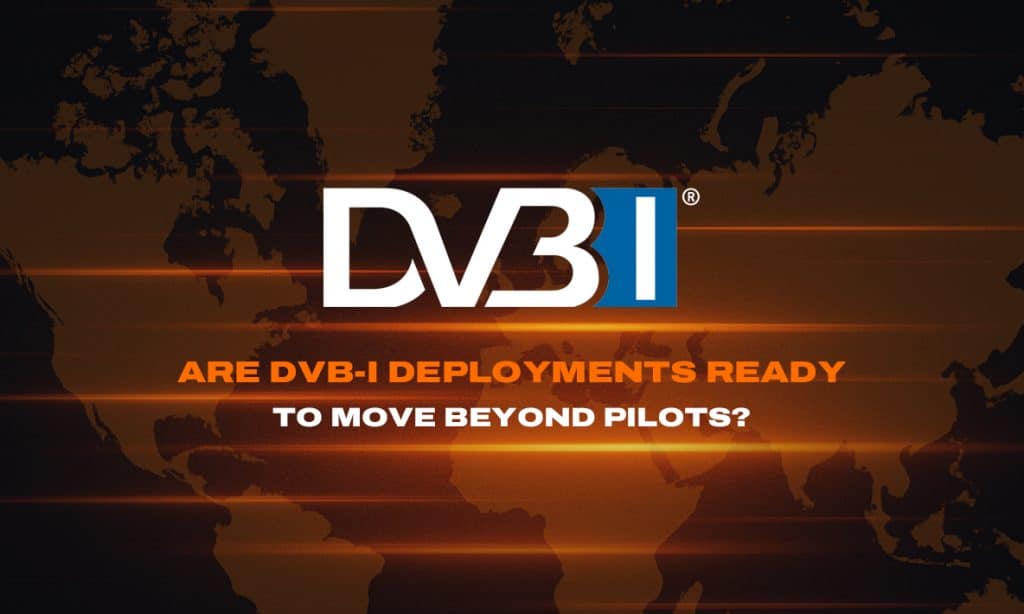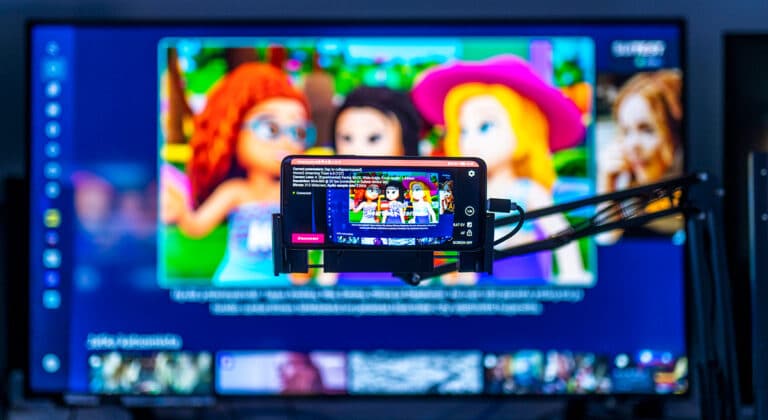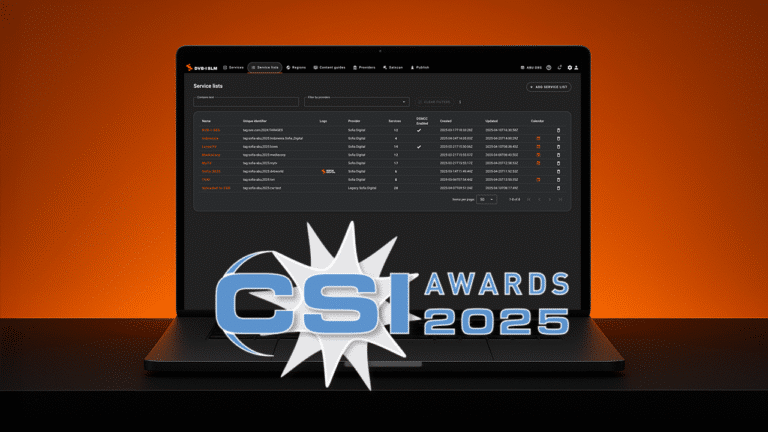
Introduction: From Specification to Real-World Use
As television continues shifting towards internet-based delivery, broadcasters and operators must handle the complexities of both traditional broadcast infrastructure and emerging IP-based distribution.
DVB-I is the standard for TV service discovery that allows receivers to find channel lists containing services in both DVB broadcast and online streaming delivery. It’s true that the streaming part of the delivery options is based on existing online/web streaming protocols (DASH and HLS), which means the delivery of the services is not different from conventional web streaming.
However, DVB-I is a standard that allows TV receivers to access complete channel lists, such as national and regional channel lineups. It includes centralized channel list management as well as standardized metadata to replace and complement conventional PSI/SI and DVB EIT formats.
Moreover, DVB-I allows seamless migration from conventional DVB broadcast (DVB-T2, DVB-S, DVB-C) into full IP-based viewing, and enables viewers to watch all available TV channels from DVB-I-compatible TV receivers without any additional applications — in the same way they have watched TV in the past, using channel numbers and zapping up/down.
Since the publication of the DVB-I specification in November 2019, several broadcasters, device manufacturers, and service providers across Europe and beyond have moved from theoretical evaluation to practical implementation. Numerous pilot projects have explored DVB-I’s capabilities under real-world conditions — including terrestrial, satellite, and hybrid delivery scenarios.
The pilots
These pilots are more than just technical trials; they aim to address practical questions relevant to actual deployment. For instance, how can DVB-I service lists presenting the TV channels be effectively managed across diverse platforms? How should they be regulated? How do DVB-I services integrate into retail consumer devices? What role do existing technologies such as HbbTV play in improving and enabling the service? And what operational insights can guide broadcasters and operators toward successful DVB-I adoption?
Sat.tv Connect, Europe
The Sat.tv Connect project, led by satellite operator Eutelsat, demonstrates DVB-I’s potential to enhance free-to-air satellite television across Europe. This initiative focused specifically on improving channel discoverability and user experience through DVB-I-based service lists and enriched Electronic Program Guide (EPG) data.
Participants
- Eutelsat
- Technology partners specializing in DVB-I and HbbTV solutions
- Device manufacturers supporting DVB-I integration
Goals of the pilot
The primary goal was to use DVB-I to improve the viewer experience for free-to-air satellite channels available on Eutelsat’s satellite positions (7/8° West, 13° East and 16° East). Sat.tv Connect aimed to provide:
- Unified and enriched service lists delivered via DVB-I specifications.
- Enhanced content discovery through metadata management and multilingual program data.
- A hybrid experience utilizing both DVB-I and HbbTV technologies, facilitating broader device compatibility.
Key aspects tested
- DVB-I service list distribution via satellite infrastructure.
- Multilingual EPG metadata and flexible user interfaces across diverse receiving devices (DVB-I compatible and legacy receivers with HbbTV support).
- End-to-end metadata management and regular synchronization from centralized cloud-based systems to consumer devices.
Results and observations
The Sat.tv Connect project successfully validated the use of DVB-I as a complement to traditional satellite broadcasting. It provided practical proof that DVB-I can significantly enhance content discoverability through dynamic channel lists and enriched EPG experiences. Furthermore, the pilot demonstrated that DVB-I could effectively coexist with HbbTV, offering seamless integration even for users without DVB-I-compatible hardware.
A significant finding was that satellite broadcasters could use DVB-I to achieve more dynamic content distribution without replacing existing infrastructure. Viewers benefited directly from improved navigation and greater content visibility, highlighting DVB-I’s value as a hybrid technology in real-world satellite environments.
More information
- For further details, see the DVB Scene Magazine (page 7).
RTÉ/Saorview DVB-I Pilot, Ireland
The Irish national broadcaster RTÉ, together with Ireland’s free-to-air digital terrestrial television (DTT) platform Saorview, conducted a DVB-I pilot to assess how the standard could enhance their existing broadcasting services and support future hybrid delivery scenarios.
Participants
- RTÉ (Ireland’s national broadcaster)
- Saorview (Ireland’s national DTT service)
- Technical cooperation with the European Broadcasting Union (EBU)
Goals of the pilot
The pilot aimed to validate DVB-I’s feasibility as a complementary technology to traditional DTT distribution. Specifically, the trial explored:
- Integration of DVB-I and HbbTV for unified service discovery.
- The viability of using DVB-I to expand content delivery beyond traditional terrestrial broadcasting.
- Real-world device compatibility and user experience in retail consumer electronics.
Key aspects tested
- Aggregation and management of DVB-I service lists for linear channels and hybrid services.
- Metadata consistency across platforms.
- Compatibility testing on commercially available smart TVs, assessing practical interoperability with DVB-I and HbbTV standards.
Results and observations
The RTÉ/Saorview pilot demonstrated DVB-I’s ability to coexist effectively with existing terrestrial broadcasting infrastructures. The trial validated service discovery capabilities and provided practical evidence that DVB-I could offer broadcasters a smooth transition towards hybrid content delivery models, combining terrestrial broadcast reliability with IP-based flexibility.
A key observation was that DVB-I significantly simplifies the viewer’s access to hybrid services by offering a unified interface for discovering both traditional broadcast and internet-delivered channels. It was noted that DVB-I integration with HbbTV created a more streamlined viewer experience and opened opportunities for new content delivery strategies, including regional and interactive services.
More information
- EBU webinar presentation by Jim Higgins, RTÉ (May 2023)
- Preparing for the next generation of free television services in Ireland
DVB-I Market Trial, Italy
The Italian DVB-I market trial involved the major broadcaster Mediaset along with key industry stakeholders, to evaluate the standard’s readiness for large-scale adoption in a hybrid broadcast-IP environment.
Participants
- Mediaset and other major Italian broadcasters
- Vestel (consumer electronics manufacturer)
- Italian industry groups and technical partners
Goals of the pilot
This pilot focused on assessing DVB-I as a practical solution for transitioning national broadcasting services from traditional Digital Terrestrial Television (DTT) towards hybrid and IP-based delivery. The trial also aimed to showcase Italy’s first commercially available DVB-I-compatible smart TV.
Key aspects tested
- Delivery of linear TV channels entirely via IP, as well as hybrid scenarios combining DTT and IP streams.
- Practical implementation of DVB-I-based service lists and metadata aggregation.
- Integration with consumer devices, including validation of DRM and content protection workflows.
Results and observations
The trial confirmed DVB-I’s practicality for broadcasters planning to shift toward IP-based distribution. A notable milestone was the introduction of Italy’s first commercially available DVB-I-compatible Smart TV from Vestel, indicating market readiness and consumer availability. Results highlighted that DVB-I effectively supported seamless channel discovery and user navigation, aligning closely with traditional viewing experiences.
More information
- Vestel and DVB-I
- Developing a DVB-I strategy for broadcasters in Italy – dvb.org
- “Mediaset’s DVB-I trial is live. Here is the proof of Internet broadcasting and the first compatible TV” – DDay.it (in Italian)
German DVB-I Pilot
The German DVB-I Pilot, coordinated by German public broadcaster ARD, has been one of the most comprehensive practical evaluations of DVB-I so far. This project brought together leading broadcasters, platform operators, technology providers and manufacturers to test DVB-I from service provisioning to viewer experience, representing a crucial milestone in the practical adoption of DVB-I standards.
Participants
- Coordinated by ARD
- Public broadcasters (ARD, ZDF and regional broadcasters)
- Commercial broadcasters (RTL, ProSiebenSat.1 and others)
- Infrastructure and technology providers, including Sofia Digital
- Device manufacturers and platform operators
Goals of the pilot
The German pilot aimed to verify DVB-I’s practical viability by thoroughly testing service discovery, metadata management, interoperability and user experience. Key objectives included:
- Evaluating DVB-I’s capability to replicate a familiar linear TV experience over IP delivery.
- Testing regionalized service lists for local channels and broadcaster-specific content.
- Exploring user interface integration and compatibility with consumer devices, including smart TVs with built-in DVB-I and HbbTV support.
Key aspects tested
- End-to-end service list provisioning and centralized metadata aggregation.
- Consistent user experience across different device models and manufacturers.
- Integration and interaction of DVB-I with existing HbbTV applications.
- Regional and local content visibility and discoverability through dynamically generated service lists.
Results and observations
The pilot provided concrete evidence of DVB-I’s maturity for widespread deployment, successfully addressing challenges in metadata handling, service-list management and interoperability. Notably, it demonstrated DVB-I’s effectiveness in maintaining the traditional TV viewing experience within IP-based infrastructures.
Sofia Digital supported the pilot by providing tools and expertise for DVB-I service list management and integration with existing HbbTV services. This contributed to the successful validation of consistent and regionalized channel-list experiences across diverse consumer devices.
The pilot’s significance was recognized internationally when it received the IBC Innovation Award 2023.
In 2024, a round table was formed to prepare for DVB-I market launch. This effort is moderated by the Bavarian Regulatory Authority for New Media (BLM), and all the major stakeholders are taking part. Since the beginning of 2025, the working groups are discussing product requirements, organization of the joint service list, ensuring non-discriminatory access for program providers and the certification of receiver devices. The project office is based at Bayerische Medien Technik (bmt).
In parallel to the Round Table, the DVB-I Task Force of Deutsche TV-Plattform is developing a technical implementation profile for receivers.
More information
- Full pilot report (PDF)
- DVB news article about the IBC Award
- Sofia Digital’s summary on German DVB-I Pilot
DVB-I Pilot, Spain
The Spanish DVB-I pilot is coordinated by RTVE and FORTA and major public and regional broadcasters are involved. It aims to evaluate the feasibility of creating a unified DVB-I service list across multiple broadcasters operating at national and regional levels.
Participants
- FORTA (the association of regional public media services)
- RTVE (national public broadcaster)
- Regional broadcasters including CCMA (Catalonia), EITB (Basque Country)
Goals of the pilot
The primary objective is to demonstrate DVB-I’s capability to streamline content discoverability and service lists across various regions and broadcast entities. Additionally, the pilot will explore integration with existing broadcast infrastructure and interactive services provided via HbbTV.
Key aspects
- Centralized service list creation and management across diverse broadcasters.
- Multiregional service list customization for different autonomous communities in Spain.
- Practical interoperability testing on retail DVB-I and HbbTV-capable devices.
Results and observations
The Spanish pilot hopes to demonstrate the value of DVB-I in enhancing viewer experience through consistent and customizable regional channel listings. The trial aims to confirm the practicality of combining multiple broadcasters’ content into a unified DVB-I structure, enabling efficient service discovery for viewers nationwide.
More information
Conclusion: DVB-I Is Ready for Deployment
These pilots demonstrate that DVB-I has progressed significantly from specification to proven technology. Across diverse scenarios—from terrestrial broadcasting in Ireland and satellite solutions like Sat.tv Connect, to ambitious national initiatives in Germany, Italy and Spain—the standard is consistently showing its effectiveness and practicality.
The findings highlight DVB-I’s strengths: reliable service discovery, seamless viewer experience, interoperability with existing standards like HbbTV and robust service management capabilities. Industry participants have validated DVB-I as not only viable but strategically advantageous for broadcasters, operators and device manufacturers considering hybrid and IP-based distribution.
For more insights on how DVB-I can be approached from a solutions perspective, see our earlier article: DVB-I: A solution-based approach to the future of television.
A comprehensive list of DVB-I trials and references to additional technical materials can be found on the official DVB-I portal: dvb-i.tv, including the dedicated deployments page: dvb-i.tv/deployments.
The message from these real-world experiences is clear: DVB-I is no longer experimental. It’s a proven standard, mature enough for immediate consideration in strategic deployments. Organizations thinking about adopting DVB-I can confidently move forward, knowing the groundwork has been thoroughly tested and validated.
Sofia Digital stands ready with complete DVB-I Client and Backend solution to support all existing and future pilots, trials and production uses. Check our products and request a live demo »





